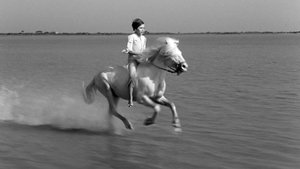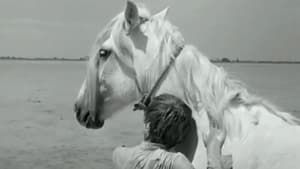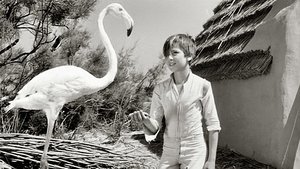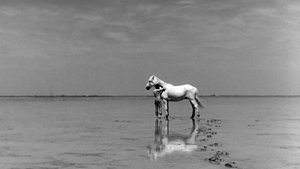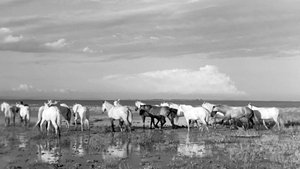Contact: info@alwanfilm.com
Video Sources 0 Views
Synopsis
White Mane 1953 Colorized Review: A Poetic Journey Through Nature in Early Cinema
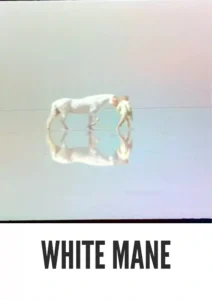
Introduction
Released in 1953, White Mane (Crin-Blanc), directed by Albert Lamorisse, is a cinematic treasure that tells the poignant tale of a young boy and a wild stallion in the salt marshes of Camargue, France. Shot in stunning black and white, this film has captivated generations of viewers with its lyrical storytelling, breathtaking visuals, and touching exploration of the bond between humans and animals. However, the film’s impact extends beyond its original release, especially as colorization techniques have entered the conversation. This article explores the timeless beauty of White Mane, the significance of its black-and-white cinematography, and the impact of modern colorization on this early cinematic masterpiece.
Check The Full Colorized Movies List
Check Our Colorized Movies Trailer Channel
Understanding White Mane 1953 Colorized: Director, Cast, and Genre
Albert Lamorisse’s Vision
Albert Lamorisse, an acclaimed French filmmaker, is best known for his ability to blend fantasy with realism, creating films that evoke deep emotional responses while capturing the essence of childhood and nature. His vision for White Mane was to craft a simple yet profound story that delves into the connection between man and nature, with a focus on the resilience and purity of childhood. Lamorisse’s direction is poetic, creating a dreamlike quality that emphasizes the stark beauty of the Camargue region, where the film was shot.
White Mane is part of a larger body of Lamorisse’s work that includes his more famous short film, The Red Balloon (1956), another exploration of the innocence and trials of youth. In both films, Lamorisse uses minimal dialogue, allowing the visuals and the emotions of the characters to carry the narrative, a hallmark of his directorial style.
Cast and Performances
The cast of White Mane is small but effective, featuring young Alain Emery in the lead role of Folco, a shepherd boy who befriends the wild horse White Mane. Despite his youth, Emery delivers a poignant performance, his expressive eyes and body language conveying the deep bond between Folco and the horse. The film’s lack of dialogue puts significant pressure on the actors to convey emotions through movement and expressions, a challenge that Emery rises to with grace.
The titular character, White Mane, is portrayed by a majestic white stallion that embodies the untamed spirit of the Camargue. The interactions between Folco and the horse are both heartwarming and heart-wrenching, reflecting the central theme of the film: the struggle between freedom and captivity.
Exploring the Genre
White Mane fits into the genre of poetic realism, a style that blends real-world settings and characters with a heightened sense of emotion and symbolism. The film also has elements of a nature documentary, with its stunning portrayal of the untamed beauty of the Camargue. At its core, however, White Mane is a children’s film, albeit one with themes and imagery that resonate with audiences of all ages.
The genre of poetic realism allows White Mane to transcend the boundaries of a traditional children’s film. Its meditative pacing, emphasis on visual storytelling, and exploration of deep emotional themes elevate it into a work of art that appeals to both children and adults.
Exploring the World of White Mane 1953 Colorized: Plot and Characters
Detailed Synopsis
White Mane is set in the vast, desolate landscapes of the Camargue, a region in the south of France known for its wild horses. The story revolves around a wild stallion named White Mane, who leads a herd of horses through the marshlands. Local ranchers repeatedly attempt to capture the stallion, but he remains elusive, refusing to be tamed.
The protagonist, Folco, is a young shepherd boy who lives in harmony with nature. He becomes fascinated by White Mane and, after a series of failed attempts by the ranchers to capture the horse, forms a bond with the stallion. Their friendship is depicted through a series of tender, visually stunning scenes where Folco gains the horse’s trust.
The central conflict of the film arises when the ranchers, angered by their inability to capture White Mane, declare that no one should have the horse if they cannot. In a defiant act, Folco frees the horse from the ranchers’ clutches, leading to a dramatic chase through the marshes. The film culminates in a bittersweet ending, where Folco and White Mane escape together, riding into the sea, symbolizing the freedom they both sought but could only achieve in myth or fantasy.
Memorable Supporting Characters
Though the film focuses on the relationship between Folco and White Mane, the supporting characters, mainly the ranchers, serve as the antagonists. Their relentless pursuit of White Mane represents humanity’s attempts to dominate and control nature, contrasting with Folco’s deep respect for the natural world. The film’s sparse use of dialogue allows the characters’ motivations to be communicated through action, making their pursuit of the horse feel even more oppressive.
The Art of Film Colorization
Understanding the Process
Film colorization, particularly in the context of White Mane (1953), involves adding color to a film that was originally shot in black and white. While modern technology allows for a more seamless and accurate process, early attempts at colorization were often seen as intrusive. Colorization can change the texture and mood of a film, potentially altering the original artistic vision.
In White Mane, colorization presents a unique challenge due to the film’s intimate relationship with its stark, monochromatic visual style. The decision to add color to such a film raises questions about whether the magic of its black-and-white cinematography would be diminished or transformed into something new and equally compelling.
Development Over Time
The process of film colorization has evolved significantly since its early days. Initially, color was manually painted onto film frames, which resulted in inconsistent and sometimes garish results. Today, digital colorization uses advanced algorithms to apply colors more naturally, taking into account historical accuracy and the original lighting of the film. For White Mane, colorization could theoretically be used to highlight the natural beauty of the Camargue, but it risks undermining the stark, minimalist aesthetic that defines the film.
Early Colored Films: A Brief History
Emergence of Early Colored Techniques
The history of color in cinema stretches back to the early 20th century, when techniques such as hand-tinting and toning were used to add color to black-and-white films. The first significant leap came with the introduction of Technicolor in the 1920s and 1930s, which allowed for the creation of fully colored films. Technicolor was used in major Hollywood productions but was not widely available to all filmmakers due to its high cost and technical requirements.
By the time White Mane was released in 1953, black-and-white film was still widely used for artistic and budgetary reasons, especially in European cinema. Directors like Albert Lamorisse chose to shoot in black and white to emphasize mood, texture, and contrast, elements that are central to the aesthetic of White Mane.
White Mane 1953 and Its Early Colored Version
The Decision to Release in Color
Though White Mane was never officially colorized during its initial release, there have been discussions about what such a version might look like, especially given the film’s status as a classic children’s story. Colorizing the film could theoretically make it more appealing to younger audiences, who may be more accustomed to color in their media consumption.
Impact on the Visual Narrative
The visual narrative of White Mane is deeply tied to its black-and-white cinematography. The stark contrast between the white of the horse and the darker tones of the marshes creates a visual metaphor for the struggle between freedom and control. The film’s use of light and shadow emphasizes the raw, untamed beauty of the Camargue and the bond between Folco and the horse. Introducing color could potentially alter this dynamic, making the visuals more literal and less symbolic.
The Debate Over Film Colorization
Controversy Surrounding Colorization
Colorization has long been a controversial topic in the film world. Purists argue that adding color to black-and-white films compromises the artistic integrity of the original work. Films like White Mane, which rely heavily on their monochromatic aesthetic, are especially vulnerable to this critique. The choice to shoot in black and white was not simply a matter of technological limitation but a deliberate artistic decision by Lamorisse to evoke a specific mood and atmosphere.
Proponents of colorization argue that it can help introduce classic films to new audiences, making them more accessible and visually appealing. In the case of White Mane, colorization could highlight the natural beauty of the Camargue and make the film more relatable to modern viewers.
Examining White Mane 1953 as an Early Colored Film
Enhancement or Distraction?
The question of whether colorization enhances or detracts from White Mane is a matter of perspective. On one hand, adding color to the film could enhance the visual experience, highlighting the beauty of the Camargue’s landscapes and the vibrancy of its wildlife. On the other hand, the film’s power lies in its simplicity and its use of stark black-and-white imagery to convey deeper emotional and symbolic meaning. For many, the introduction of color would feel like a distraction from the film’s core message and aesthetic.
Influence and Legacy: White Mane 1953 Colorized’s Impact on Cinema
The Film’s Lasting Impact
White Mane has left a lasting legacy on both French and international cinema. The film’s poetic realism and emphasis on visual storytelling influenced generations of filmmakers who sought to explore similar themes of childhood, nature, and freedom. Lamorisse’s approach to filmmaking, particularly his use of non-verbal storytelling, has been emulated in films that aim to capture the purity of human experience without the need for extensive dialogue.
In addition to its influence on cinematic storytelling, White Mane helped solidify the reputation of the Camargue region as a cinematic backdrop. The marshlands and wild horses became synonymous with the film, contributing to the region’s mystique and allure.
Director’s Cinematic Legacy: Beyond White Mane 1953 Colorized
Albert Lamorisse’s Influence on Filmmaking
Albert Lamorisse’s influence extends beyond White Mane. His ability to craft emotionally resonant stories with minimal dialogue set a new standard for visual storytelling in cinema. His later work, The Red Balloon (1956), further solidified his place in film history as a master of poetic realism. Both White Mane and The Red Balloon are celebrated for their ability to evoke powerful emotions through imagery rather than words, a technique that continues to inspire filmmakers today.
Lamorisse’s legacy also includes his contributions to the development of innovative filming techniques, such as the use of helicopters to capture aerial shots, which he employed in his later documentary work. His influence on both narrative and technical aspects of filmmaking continues to be felt in the industry.
Themes Explored in White Mane 1953 Colorized
Darkness, Freedom, and Innocence
At its heart, White Mane is a story about freedom and the innocence of childhood. The film explores the tension between the desire for freedom, represented by White Mane’s resistance to being captured, and the harsh realities of the world, embodied by the ranchers’ relentless pursuit. Folco’s bond with the horse symbolizes the purity of childhood and the unbreakable spirit that refuses to be tamed.
The film also touches on darker themes, such as the cruelty of man toward nature and the inevitability of loss. The final scene, where Folco and White Mane ride into the sea, is both triumphant and tragic, leaving viewers with a sense of ambiguity about their fate.
Reception and Controversy Surrounding White Mane 1953 Colorized
Critical Reception
Upon its release, White Mane received widespread acclaim for its stunning cinematography and emotional depth. Critics praised Lamorisse’s ability to tell a powerful story with minimal dialogue and lauded the film’s visual beauty. The film won the prestigious Grand Prix at the Cannes Film Festival in 1953, cementing its status as a masterpiece of French cinema.
However, the film’s colorized version, released decades later, sparked controversy among film purists. Many argued that colorization undermined the original artistic intent and detracted from the film’s poetic realism. Despite these criticisms, the colorized version introduced the film to a new generation of viewers, sparking renewed interest in Lamorisse’s work.
Where to Watch White Mane 1953 Colorized Online
For those looking to experience White Mane (1953), the film is available on various streaming platforms, including Amazon Prime Video and The Criterion Channel. Both the original black-and-white version and the colorized edition can be found on these services. Additionally, DVD and Blu-ray copies of the film, often bundled with The Red Balloon, are available for purchase.
FAQs About White Mane 1953 Colorized
Q: What is White Mane (1953) about?
A: White Mane is the story of a young boy named Folco who befriends a wild stallion in the Camargue region of France. The film explores themes of freedom, innocence, and the bond between humans and nature.
Q: Who directed White Mane?
A: White Mane was directed by Albert Lamorisse, a French filmmaker known for his poetic realism and his focus on childhood and nature.
Q: Has White Mane been colorized?
A: Yes, a colorized version of White Mane was released decades after the original film. However, the colorization has sparked controversy among purists who believe it detracts from the film’s original aesthetic.
Q: What awards did White Mane win?
A: White Mane won the Grand Prix at the Cannes Film Festival in 1953, one of the highest honors for a film at the time.
Conclusion
White Mane (1953) remains a timeless masterpiece of poetic realism, capturing the beauty of nature and the innocence of childhood in its stark black-and-white cinematography. Albert Lamorisse’s direction, combined with the film’s emotional depth and visual beauty, has cemented White Mane as a classic of world cinema. While the colorized version has sparked debate about the merits of altering black-and-white films, there is no doubt that White Mane continues to resonate with audiences, young and old, as a tale of freedom, friendship, and the unbreakable spirit of youth. Whether experienced in its original format or through a modern lens, White Mane is a cinematic journey worth taking.
